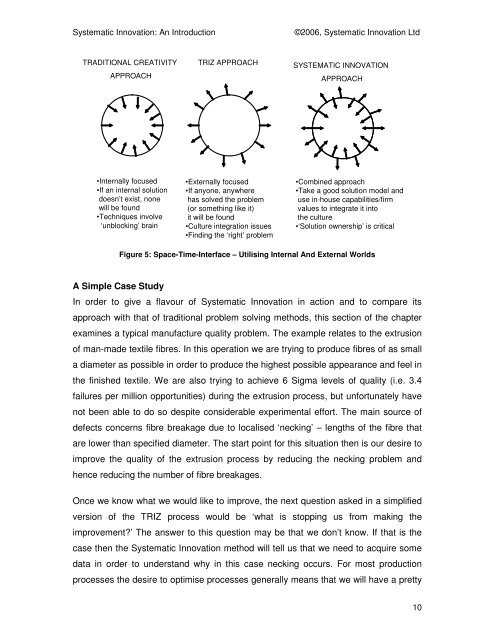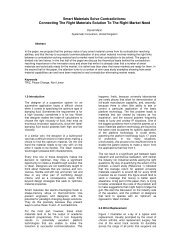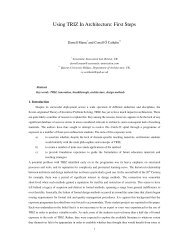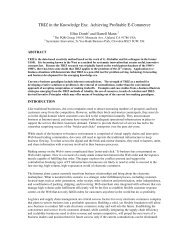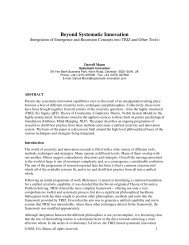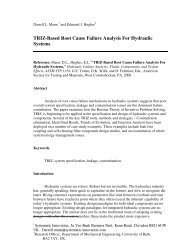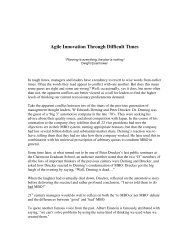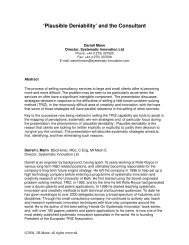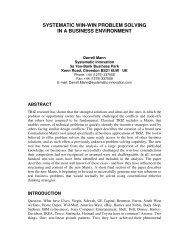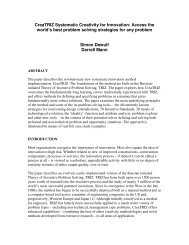Systematic Innovation: An Introduction - Systematic Innovation, TRIZ
Systematic Innovation: An Introduction - Systematic Innovation, TRIZ
Systematic Innovation: An Introduction - Systematic Innovation, TRIZ
You also want an ePaper? Increase the reach of your titles
YUMPU automatically turns print PDFs into web optimized ePapers that Google loves.
<strong>Systematic</strong> <strong>Innovation</strong>: <strong>An</strong> <strong>Introduction</strong><br />
©2006, <strong>Systematic</strong> <strong>Innovation</strong> Ltd<br />
TRADITIONAL CREATIVITY<br />
APPROACH<br />
<strong>TRIZ</strong> APPROACH<br />
SYSTEMATIC INNOVATION<br />
APPROACH<br />
•Internally focused<br />
•If an internal solution<br />
doesn’t exist, none<br />
will be found<br />
•Techniques involve<br />
‘unblocking’ brain<br />
•Externally focused<br />
•If anyone, anywhere<br />
has solved the problem<br />
(or something like it)<br />
it will be found<br />
•Culture integration issues<br />
•Finding the ‘right’ problem<br />
•Combined approach<br />
•Take a good solution model and<br />
use in-house capabilities/firm<br />
values to integrate it into<br />
the culture<br />
•‘Solution ownership’ is critical<br />
Figure 5: Space-Time-Interface – Utilising Internal <strong>An</strong>d External Worlds<br />
A Simple Case Study<br />
In order to give a flavour of <strong>Systematic</strong> <strong>Innovation</strong> in action and to compare its<br />
approach with that of traditional problem solving methods, this section of the chapter<br />
examines a typical manufacture quality problem. The example relates to the extrusion<br />
of man-made textile fibres. In this operation we are trying to produce fibres of as small<br />
a diameter as possible in order to produce the highest possible appearance and feel in<br />
the finished textile. We are also trying to achieve 6 Sigma levels of quality (i.e. 3.4<br />
failures per million opportunities) during the extrusion process, but unfortunately have<br />
not been able to do so despite considerable experimental effort. The main source of<br />
defects concerns fibre breakage due to localised ‘necking’ – lengths of the fibre that<br />
are lower than specified diameter. The start point for this situation then is our desire to<br />
improve the quality of the extrusion process by reducing the necking problem and<br />
hence reducing the number of fibre breakages.<br />
Once we know what we would like to improve, the next question asked in a simplified<br />
version of the <strong>TRIZ</strong> process would be ‘what is stopping us from making the<br />
improvement?’ The answer to this question may be that we don’t know. If that is the<br />
case then the <strong>Systematic</strong> <strong>Innovation</strong> method will tell us that we need to acquire some<br />
data in order to understand why in this case necking occurs. For most production<br />
processes the desire to optimise processes generally means that we will have a pretty<br />
10


